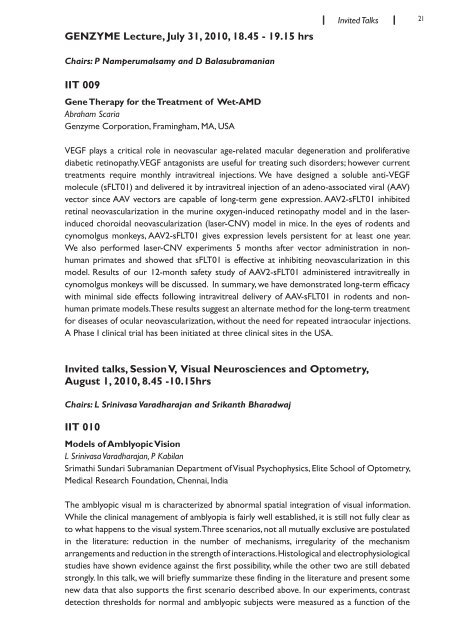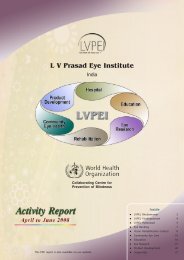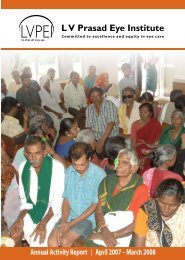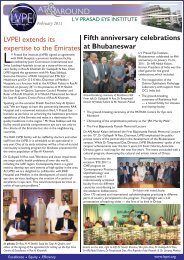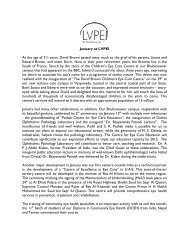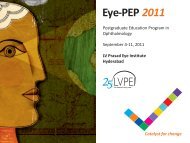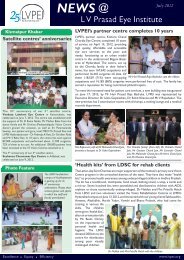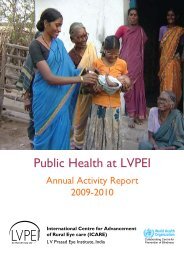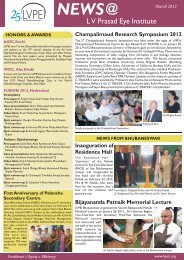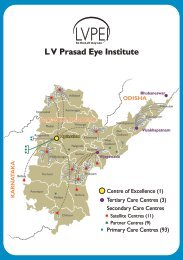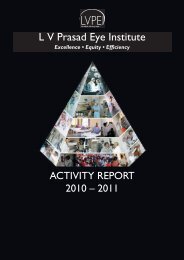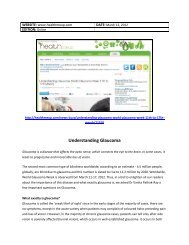IERG Abstracrt Book.indd - LV Prasad Eye Institute
IERG Abstracrt Book.indd - LV Prasad Eye Institute
IERG Abstracrt Book.indd - LV Prasad Eye Institute
You also want an ePaper? Increase the reach of your titles
YUMPU automatically turns print PDFs into web optimized ePapers that Google loves.
GENZYME Lecture, July 31, 2010, 18.45 - 19.15 hrsInvited Talks21Chairs: P Namperumalsamy and D BalasubramanianIIT 009Gene Therapy for the Treatment of Wet-AMDAbraham ScariaGenzyme Corporation, Framingham, MA, USAVEGF plays a critical role in neovascular age-related macular degeneration and proliferativediabetic retinopathy. VEGF antagonists are useful for treating such disorders; however currenttreatments require monthly intravitreal injections. We have designed a soluble anti-VEGFmolecule (sFLT01) and delivered it by intravitreal injection of an adeno-associated viral (AAV)vector since AAV vectors are capable of long-term gene expression. AAV2-sFLT01 inhibitedretinal neovascularization in the murine oxygen-induced retinopathy model and in the laserinducedchoroidal neovascularization (laser-CNV) model in mice. In the eyes of rodents andcynomolgus monkeys, AAV2-sFLT01 gives expression levels persistent for at least one year.We also performed laser-CNV experiments 5 months after vector administration in nonhumanprimates and showed that sFLT01 is effective at inhibiting neovascularization in thismodel. Results of our 12-month safety study of AAV2-sFLT01 administered intravitreally incynomolgus monkeys will be discussed. In summary, we have demonstrated long-term efficacywith minimal side effects following intravitreal delivery of AAV-sFLT01 in rodents and nonhumanprimate models. These results suggest an alternate method for the long-term treatmentfor diseases of ocular neovascularization, without the need for repeated intraocular injections.A Phase I clinical trial has been initiated at three clinical sites in the USA.Invited talks, Session V, Visual Neurosciences and Optometry,August 1, 2010, 8.45 -10.15hrsChairs: L Srinivasa Varadharajan and Srikanth BharadwajIIT 010Models of Amblyopic VisionL Srinivasa Varadharajan, P KabilanSrimathi Sundari Subramanian Department of Visual Psychophysics, Elite School of Optometry,Medical Research Foundation, Chennai, IndiaThe amblyopic visual m is characterized by abnormal spatial integration of visual information.While the clinical management of amblyopia is fairly well established, it is still not fully clear asto what happens to the visual system. Three scenarios, not all mutually exclusive are postulatedin the literature: reduction in the number of mechanisms, irregularity of the mechanismarrangements and reduction in the strength of interactions. Histological and electrophysiologicalstudies have shown evidence against the first possibility, while the other two are still debatedstrongly. In this talk, we will briefly summarize these finding in the literature and present somenew data that also supports the first scenario described above. In our experiments, contrastdetection thresholds for normal and amblyopic subjects were measured as a function of the


